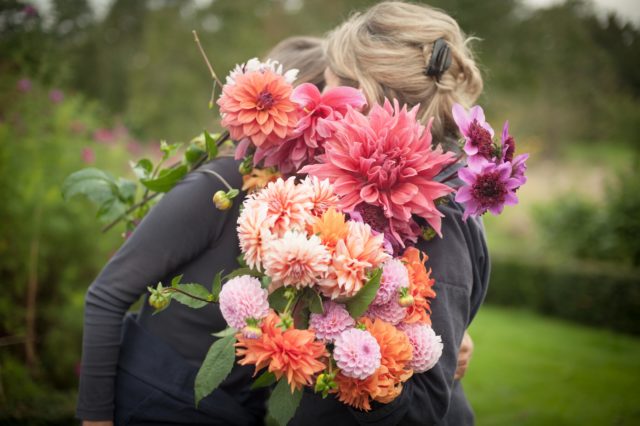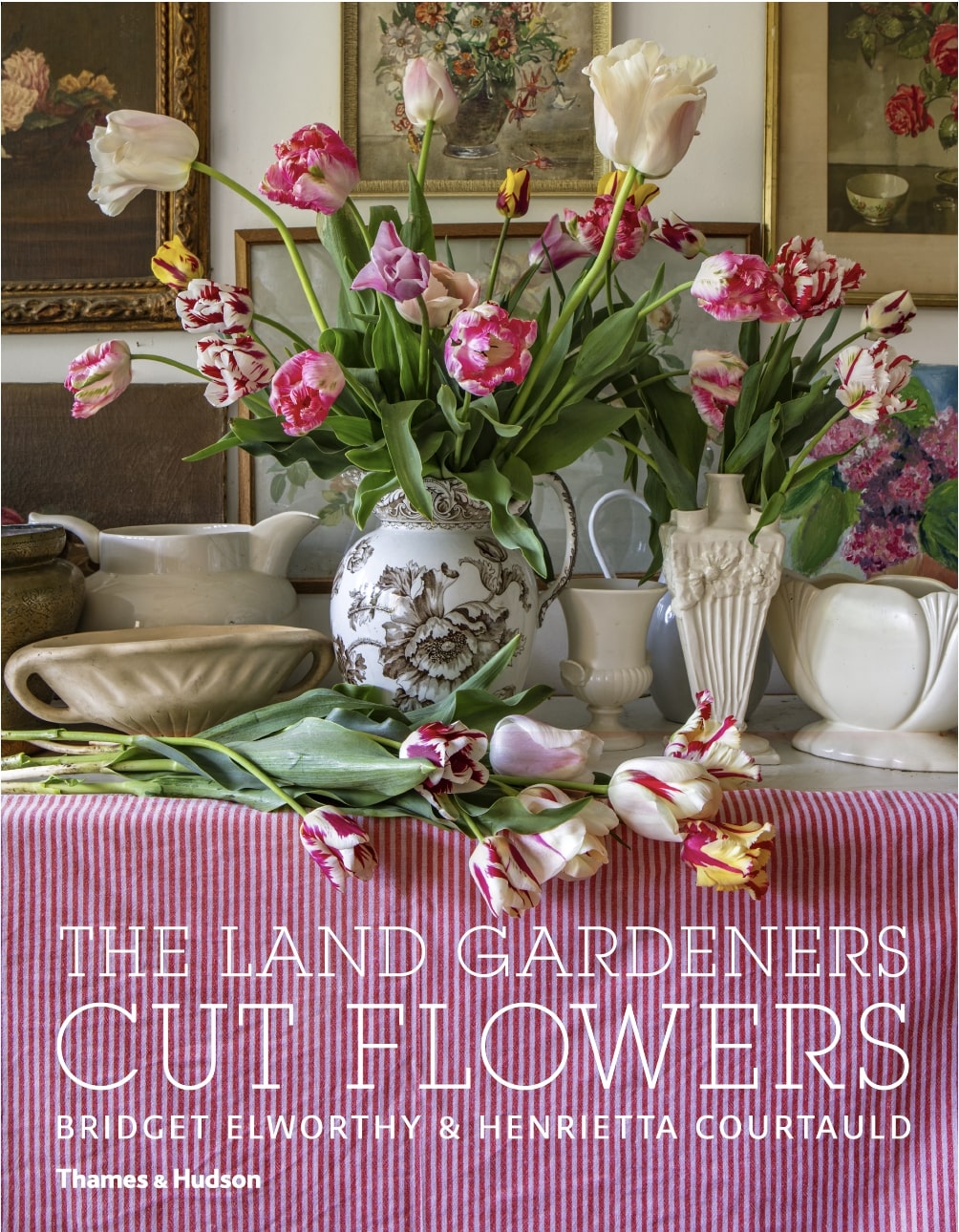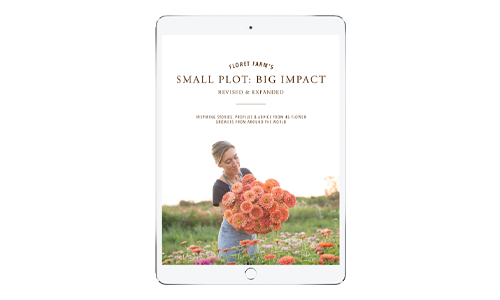When we traveled to England last June, I had the pleasure of meeting Henrietta Courtauld and Bridget Elworthy of The Land Gardeners. Our visit to their home and garden was one of the highlights of our trip. Their warmth, enthusiasm, and hospitality was so inspiring. I was given a peek at the early proofs of their book, which felt so indulgent. I’m excited to learn more about the making of their book, The Land Gardeners: Cut Flowers, which releases in May, and to dive into their approach to healthy soil, a passion we all share.
 Erin: Henrietta and Bridget, thanks so much for taking time to share your story with Floret readers. For those not familiar with your work, can you share an overview of your story, as well as an overview of your new book?
Erin: Henrietta and Bridget, thanks so much for taking time to share your story with Floret readers. For those not familiar with your work, can you share an overview of your story, as well as an overview of your new book?
The Land Gardeners: We established The Land Gardeners in 2012 to research plant and soil health through growing, cutting and designing. We design productive gardens—wild, romantic and joyful—and restore walled gardens and historic gardens in England and abroad. We grow organic English cut flowers in Oxfordshire and run workshops, exploring healthy plants, healthy soil, and biodiverse, living gardens. Our research into soil health led us to launch our new business, Climate Compost, working with farmers and gardeners to coach them to make high-quality, microbially active compost, and selling our own compost for gardens and farms.
 Our business is based at Wardington Manor, a rambling Jacobean manor house in Oxfordshire, England, set within Arts and Crafts gardens which once provided cut flowers for the great and the good of London society. We have revived these cutting gardens, growing and gathering glorious flowers for London florists and homes, and bringing the manor and gardens alive with their floral circus. Our buckets of blowsy dahlias, silky peonies, long trails of roses, metre-tall tulips, and generous blooms evoke an almost other-worldly era of glamour.
Our business is based at Wardington Manor, a rambling Jacobean manor house in Oxfordshire, England, set within Arts and Crafts gardens which once provided cut flowers for the great and the good of London society. We have revived these cutting gardens, growing and gathering glorious flowers for London florists and homes, and bringing the manor and gardens alive with their floral circus. Our buckets of blowsy dahlias, silky peonies, long trails of roses, metre-tall tulips, and generous blooms evoke an almost other-worldly era of glamour.
In our book, we hope to inspire others to create their own cutting gardens in which they share their favorite flowers, their knowledge on how to grow and what to gather by season. We tell our story and share our beliefs on growing organically, and on soil health, which is central to all our work.
Erin: Your book is just stunning, and it is very well-rounded: part history, part flower arranging, part gardening. It is very thorough, and it must have been a serious undertaking. Can you tell us about the process of making this book?
The Land Gardeners: It was obvious to us that there were already two brilliant, definitive “how-to” books on growing cut flowers by you, Erin, and by Sarah Raven in England. We hoped, instead, that our readers would be interested to learn our story of restoring and reviving the cutting gardens at Wardington Manor whilst also giving them inspiration and ideas for what they could gather and grow themselves.
We were keen to help other gardeners connect with the seasons and their gardens, and to grow their own cut flowers. Gathering photos for the book took several years; over time we took photographs of the garden as it developed and of our favorite flowers—and we were lucky to be visited by some of the most talented garden photographers: Clive Nichols, Clare Richardson, Miguel Flores-Vianna, Andrew Montgomery, and Hugo Rittson-Thomas. However, writing the book was a whirlwind. We sat down together over the winter months, drank countless cups of tea by the fire and talked and talked, and wrote and wrote.
Erin: Your garden is at Bridget’s home, Wardington Manor, in Oxfordshire, which has a remarkable history. Can you give us a brief overview of the history as it pertains to the gardens?
The Land Gardeners: Wardington Manor was built in the the 15th century as a nunnery, reconfigured in 1665, and then added to in the early 20th century first by Clough Williams-Ellis, and later by G. H. Kitchin and Randall Wells, both of whom were advocates of the Arts and Craft traditions of valuing craftsmanship over mass manufacturing and the romance of the medieval over the modern.
The house now rambles over different levels; staircases appear from behind curtains, and mullioned windows look out onto green terraced lawns. The gardens weave around the house: a meander of rooms in the Arts and Crafts tradition, backed by rust-colored Ironstone walls and high yew hedges. In summer it erupts in a profusion of willful flowers, soaring up out of the beds and seeding in the walls and paths.
 What is perhaps most extraordinary is that there is a long tradition of growing flowers at the Manor, which we have revived. When John Pease and his wife, later the first Lord and Lady Wardington, bought the house in 1917, the bones of the garden were already in place. Lady Wardington in particular loved the garden, and along with other ladies of large country houses, was cutting flowers during the 40s, 50s, and 60s from the borders and driving them down to London to eminent florists: Constance Spry, and Poulbrook and Gould.
What is perhaps most extraordinary is that there is a long tradition of growing flowers at the Manor, which we have revived. When John Pease and his wife, later the first Lord and Lady Wardington, bought the house in 1917, the bones of the garden were already in place. Lady Wardington in particular loved the garden, and along with other ladies of large country houses, was cutting flowers during the 40s, 50s, and 60s from the borders and driving them down to London to eminent florists: Constance Spry, and Poulbrook and Gould.
Audrey, the second Lady Wardington, continued her mother-in-law’s tradition of cut flowers, filling her car full of flowers and children, much to the children’s discomfort! However, cut flowers were not her passion, and after 5 years she decided her time was better spent elsewhere. The cutting gardens over the road were turned into pony paddocks and a riding arena for their children and years later into allotments for the village.
 Erin: You write, “We always strive to give a garden a purpose, particularly a productive purpose, as a place from which you can gather herbs, fruits, flowers and vegetables.” I’d love to hear more about this philosophy, and about how you select varieties that are unusual, useful, wild, and ultimately very appealing to the London market and high-end designers.
Erin: You write, “We always strive to give a garden a purpose, particularly a productive purpose, as a place from which you can gather herbs, fruits, flowers and vegetables.” I’d love to hear more about this philosophy, and about how you select varieties that are unusual, useful, wild, and ultimately very appealing to the London market and high-end designers.
The Land Gardeners: We love making a garden productive, making it a place from which you can gather all year round, whether this is a dedicated cut flower or vegetable bed, or an orchard, or even an edible hedgerow. We are always thinking about what we or our clients can pick. This means that we connect with our garden. It is not just a beautiful place to look at, but a place from which you can gather, connecting with nature and the seasons.
We love the unusual, often buying our seeds from The Real Seed Company (www.realseeds.co.uk) which sells organic, heirloom, and heritage vegetable seeds. One of most recent finds is black salsify (Scorzanera hispanica); you can eat the roots and use the soaring yellow flowers in arrangements. Similarly with parsnip. This is a delicious vegetable, but we always let a row go to seed so we can use its towering, umbelliferous flowers in tall vases.
 Erin: Your garden has several distinct areas including The Walled Garden, The Cutting Garden, The Dahlia and Tulip Border, The Perennials Border, The Pond Walk, The Orchard, and The Church Walk. Can you tell me a bit about your favorite areas of the garden and why?
Erin: Your garden has several distinct areas including The Walled Garden, The Cutting Garden, The Dahlia and Tulip Border, The Perennials Border, The Pond Walk, The Orchard, and The Church Walk. Can you tell me a bit about your favorite areas of the garden and why?
The Land Gardeners: We find that we tend to gravitate towards a particular area of the garden as the seasons change. We start picking shrubs and bulbs from The Pond Walk in spring, move to The Perennials Border and Cutting Garden in high summer, then back to the Dahlia Border in autumn, finishing the growing year picking snowdrops from The Church Walk in the depths of winter.
However, our favorite area is probably The Walled Garden. Protected by its old walls, and sunny all day long, it heaves with flowers, fruit, herbs, and vegetables, which buzz with bees and insects.
We also love the orchard. This is such an easy-maintenance area from which we gather all year round, both bulbs and flowers growing in the long grass: snowdrops, crocus, narcissi, tulips, camassias, cow parsley, and armfuls of blossom and fruit from the fruit trees themselves.
And our Dahlia and Tulip Border is our circus. It’s filled with riotous color. We gather armfuls of long-stemmed tulips in spring and then huge bunches of dahlias in autumn.
 Erin: You are passionate about soil health and really excited about microbes. Can you tell me about your approach to healthy soil?
Erin: You are passionate about soil health and really excited about microbes. Can you tell me about your approach to healthy soil?
The Land Gardeners: We stand on the precipice of climate disaster, with dangerously high and rising levels of CO2 in the atmosphere. But as gardeners, designers, and farmers, we have the ability to reverse this process if we all work together with the soil to create an atmosphere-cleansing machine. A key ingredient in this process is aerobic microbe-rich compost. It is now thought that soil microbes work with the soil, plants, and atmosphere to provide potential for sequestration of carbon in the atmosphere, thus allowing our soil to act as a massive carbon sink. If you have the ability to tend your soil, whether you are a large-scale farmer or a gardener, you have the ability to nurture life on our planet. And if you grow fruit and vegetables, you have the ability to improve their nutrient density through improving the soil in which they are grown.
 Erin: What are you currently working on, dreaming of, excited about in your life and work?
Erin: What are you currently working on, dreaming of, excited about in your life and work?
The Land Gardeners: We are excited about improving our soil, plant and garden health: minimal tilling, planting green manures, increasing the biodiversity of plants, planting hedgerows, creating areas of agro-forestry, and most important of all, creating microbially rich compost. Our aim is to encourage growers and farmers to sequester carbon in the soil. We want them to be not only carbon zero but carbon positive. Anyone has the ability to do this even if they are just growing a plant in a pot on their terrace!
Erin: Anything else you’d like to share?
The Land Gardeners: We’d just like to say thank you! You are so generous with your information on how to grow cut flowers and we, like so many growers around the world, have benefited from your knowledge and abundant joy.
Erin: Thank you so much for taking the time to talk with us, Henrietta and Bridget. I’m so inspired by all that you do, and I look forward to the next time our paths cross.

I’m thrilled to give away 5 copies of Henrietta and Bridget’s beautiful book, The Land Gardeners: Cut Flowers. For a chance to win, simply post a comment below. In your comment, please share what spring flower you’re most excited about. Winners will be announced on Monday, May 11th.
UPDATE: The giveaway is now closed. The winners are: Lizzie Wysong-Schmidt, Carol Peterson, Lorrie Sutherland, Mary Welch and Heather Morrill.
Learn more and connect with Henrietta and Bridget of The Land Gardeners
Website: www.thelandgardeners.com
Book: The Land Gardeners: Cut Flowers (Thames & Hudson, May 2020)
Instagram: @thelandgardeners
Photos courtesy of The Land Gardeners.







Ted Warren on
Excellent article. Gardening is really all about the soil.